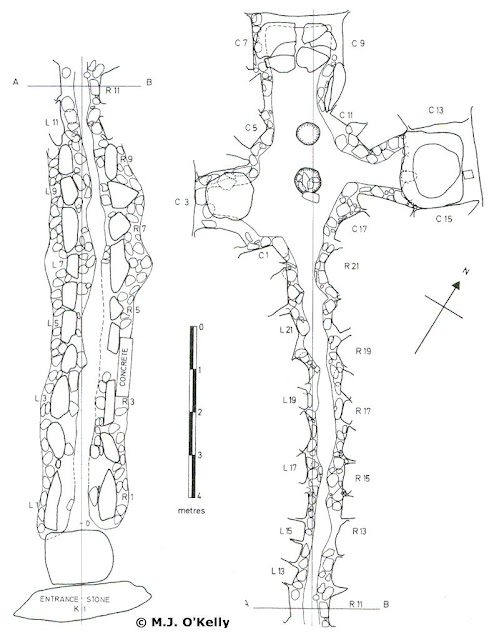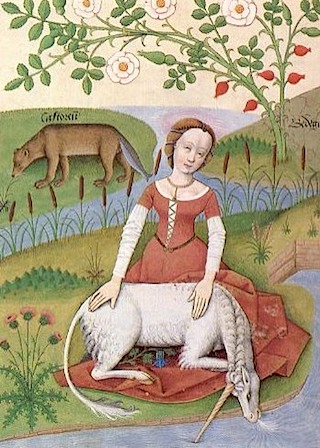...As he spoke, he paused before a great mound grown over with trees, and around it silver clear in the moonlight were immense stones piled, the remains of an original circle, and there was a dark, low, narrow entrance leading within…
‘This was my palace. In days past many a one plucked here the purple flower of magic and the fruit of the tree of life…but look: you will see it is the palace of a god.’
And even as he spoke, a light began to glow and to pervade the cave, and to obliterate the stone walls and the antique hieroglyphics engraved thereon, and to melt the earthen floor into itself like a fiery sun suddenly uprisen within the world, and there was everywhere a wandering ecstasy of sound: Light and sound were one; light had a voice, and the music hung glittering in the air…
‘I am Aengus…men call me the Young. I am the sunlight in the heart, the moonlight in the mind; I am the light at the end of every dream, the voice for ever calling to come away; I am the desire beyond joy or tears. Come with me, come with me: I will make you immortal; for my palace opens into the Gardens of the Sun, and there are the fire-fountains which quench the heart’s desire in rapture.’
-- by George William Russell, “A Dream of Angus Oge,” 1897
 |
| Amanece sobre Newgrange durante el Solsticio, desde el Rio Boyne - Foto de R.C. Ardill |
Newgrange está considerado como el monumento megalítico más complejo de Irlanda, y posiblemente de Europa, pero a pesar del enorme interés que despierta su alineación solar y el espectacular alumbramiento de la camara central en el interior de la tumba de pasadizo durante el solsticio de invierno, poco mas se sabe acerca de las razones que llevaron al establecimiento y desarrollo del monumento en esta ubicación, un milenio antes de la construcción de Stonehenge o 5 siglos antes que lass pirámide de Gizah.
 |
| Newgrange, vista alineada con el pasadizo (SSE) |
 |
| Newgrange, vista aerea desde el sur |
 |
| Newgrange, plano de planta |
El montículo megalítico de Newgrange se asienta a orillas del río Boyne y forma parte del complejo sagrado más famoso de Irlanda, conocido como Brú na Bóinne. ¿Por qué aquí? El río Boyne, o Boand, significa “vaca blanca” y como la diosa del mismo nombre, se dice que el rio refleja a su vez el otro rio celestial, la Vía Láctea. Además, también se dice que las aguas del Boyne conceden un poder de visión sobrenatural, manifestando así su valor no solo sagrado sino también iniciático.
Newgrange es un monumento impresionante, un montículo de piedras construido a partir de unas 200.000 toneladas de granito procedente de la bahía de Dundalk, además de cuarzo blanco traído desde las montañas Wicklow. Estaba rodeada por un círculo de 38 monolitos, de los cuales siguen en pie sólo 12. Pero lo que ha otorgado mayor fama a este complejo es el intrincado espectáculo solar que concibieron sus diseñadores, que no se limita a Newgrange, si no que se extiende a los demás túmulos (o “cairns”) del complejo.
 |
| Newgrange |
 |
| Newgrange |
 |
| Newgrange |
Durante el solsticio de invierno, después de amanecer en el pasadizo de Newgrange y alcanzar la luz el fondo de la camara, el sol va visitando diferentes túmulos menores durante el día, en particular el conocido como túmulo K al mediodía y por ultimo el gran montículo de Dowth al atardecer. Esto significa que el rayo de sol está “contenido” de manera constante dentro de un túmulo durante todo el día más corto del año, como si "perderlo" supusiera el riesgo de nunca más encontrarlo.
 |
| Newgrange, entrada al pasadizo |
 |
| Newgrange, pasadizo: el desnivel de 2m. permite que la abertura sobre el dintel (roofbox) este alineada con la camara central, pudiendo asi ser iluminada en el solsticio |
 |
| Newgrange, detalle de los petroglifos en la entrada |
Cuál es el papel de Knowth, el tercer gran túmulo de los situados en esta curva del rio Boyne? Knowth es de hecho el mayor túmulo que existe en Irlanda y fue construido 500 años antes que Newgrange, pero a pesar de ello carece de la importancia mitológica que este tiene. Con todo también disfruta de su propio espectáculo solar: su pasadizo se ilumina en los amaneceres de ambos equinoccios, los días 21 de Marzo y Septiembre. Knowth también es conocido por albergar un calendario lunar, la piedra o bordillo 52; en ella aparecen diferentes petroglifos semejantes a medias lunas que sugieren que los antiguos astrónomos que poblaron el Valle del Boyne pudieron haber determinado la sincronización de las fases de la Luna con el año solar.Gillies MacBain también observa que Knowth tiene un bordillo formado por 127 grandes losas, que es justamente la mitad del total de meses o lunas tropicales (en lugar de meses siderales) según el ciclo metónico. Habiendo visto como pudieron alinear perfectamente Newgrange con el solsticio de invierno, no debe sorprender que alcanzaran la misma precisión con el ciclo lunar.
 |
| Knowth, vista area |
 |
| Knowth, bordillo lateral |
 |
| Knowth, kerbstone 52 |
Pero volviendo a Newgrange, el autor Hugh Kearns especula que durante el solsticio, cuando el haz de luz penetraba en el pasadizo, terminaba por iluminar un gran disco de oro colgado en la cámara al final del mismo y a su vez el haz reflejado iluminaba el rio Boyne. No existe evidencia arqueológica de esto, aunque Kearns comprobó con éxito la viabilidad de esta hipótesis en un modelo a escala. Claro que todo depende de la existencia o no del disco. Lo que si es cierto es que la luz del amanecer, además de recorrer el pasadizo, alumbraba el cuarzo blanco que recubre el túmulo, haciendo que todo el monumento brillara (y brille hoy en día) con gran intensidad al amanecer. Kearns también creía que las celebraciones del solsticio se acompañaban de música, convirtiendo a Newgrange en un autentico espectáculo de luz y sonido. Hipótesis en parte apoyada por Paul Devereux, que hizo un análisis acústico de la estructura.
 |
| Newgrange, fachada lateral |
 |
| Newgrange, detalle de la cobertura con piedras de cuarzo |
Dejando a un lado esta hipótesis poco fundada, Kearns destaca la gigantesca población de salmón en el Valle del Boyne durante la época del solsticio de invierno. La mitología celta recoge que los héroes consultaban al salmón como animal sagrado, por su sabiduría y previsión; ingerir el “Salmón del Conocimiento” o “Eo Feasa” suponía adquirir su sabiduría de manera inmediata.
El salmón aparece con frecuencia en esta mitología: Gwyrhr interroga a una serie de animales sabios, cada una mas que el anterior. El más viejo y sabio de todos es el salmón de Llyn Llyw. Cúchulainn necesitó usar el sagrado salto del salmón para cruzar el puente de Eel’s-Tail y así alcanzar la fortaleza de Scáthach y acceder a su superior conocimiento de las armas.
En general se creía que el salmón otorgaba sabiduría e intelecto y si a eso se le suman los poderes sobrenaturales de las aguas del Boyne, la ingesta de ambos permitiría al iniciado adquirir el conocimiento oculto del mas allá.
Todo ello sugiere que la abundancia de salmón durante el solsticio pudo haber marcado la localización como un lugar sagrado desde mucho antes de la expansión de los pueblos celtas, convirtiéndose milenios después en un importante centro religioso.
El salmón aparece con frecuencia en esta mitología: Gwyrhr interroga a una serie de animales sabios, cada una mas que el anterior. El más viejo y sabio de todos es el salmón de Llyn Llyw. Cúchulainn necesitó usar el sagrado salto del salmón para cruzar el puente de Eel’s-Tail y así alcanzar la fortaleza de Scáthach y acceder a su superior conocimiento de las armas.
En general se creía que el salmón otorgaba sabiduría e intelecto y si a eso se le suman los poderes sobrenaturales de las aguas del Boyne, la ingesta de ambos permitiría al iniciado adquirir el conocimiento oculto del mas allá.
Todo ello sugiere que la abundancia de salmón durante el solsticio pudo haber marcado la localización como un lugar sagrado desde mucho antes de la expansión de los pueblos celtas, convirtiéndose milenios después en un importante centro religioso.
 |
| Newgrange, vista de la entrada desde el pasadizo y abertura por donde penetra el sol en el solsticio |
 |
| Newgrange, estrechamiento del pasadizo (L7 en el plano) |
 |
| Newgrange, plano detallado del pasadizo |
Por otra parte el lugar se conocía como la “curva del rio de la diosa Vaca Blanca” o “Boand”. Obviamente la vaca es el origen de la leche lo que lleva fácilmente a la Vía Láctea o la “Vía de la Vaca Blanca”. A su vez, el salmón retorna rio arriba a su lugar de nacimiento, donde dará lugar a nueva vida, cerrando su ciclo. El rio Boyne es uno de estos lugares.
El salmón se identifica con el conocimiento y el ser humano siempre busca el conocimiento divino que se cree procede de las estrellas, allí donde los chamanes fueron. Quizás capturar el rayo del sol en el día mas corto era un símbolo de como el poder del Sol quedaba retenido en esta curva del Boyne? Poder que de alguna manera era traspuesto al salmón? A su vez, aquellos que comían el salmón adquirirían el conocimiento sagrado, con la mediación de la luz solar.
La Vía Láctea y el rio Boyne formaban por tanto el camino iniciático, y el salmón era el Chaman, el viajero, en busca de su origen, pero también de su destino. El salmón adquiría el conocimiento tras ingerir las nueve avellanas de la sabiduría que cayeron a la Fuente de “Segais”, la fuente primaria del saber en la tradición Celta.
Nechtán era uno de los guardianes de la fuente de Segais, junto con sus hermanos Flesc, Lám y Luam. Nadie más podía acceder a ella, ni siquiera los dioses. Pero, al igual que Eva se dejo cautivar por la serpiente, la esposa de Nechtán, Boand, decidió desobedecer la orden y por su culpa, el conocimiento sagrado vio la luz: ya no se podía detener el agua que manaba de la fuente y así nació el rio Boyne. Y al igual que con Adán y Eva, llego el castigo y Boan pereció ahogada, aunque el rio tomó de ella su nombre. De esta manera se convierte en el símbolo perfecto del Chaman, que va en busca del conocimiento sagrado al otro mundo, y lo trae de vuelta divulgándolo.
 |
| Newgrange, camara central, vista hacia el pasadizo y petroglifos espirales |
 |
| Newgrange, detalle de la boveda sobre la camara central |
El camino que recorre el Chaman se identifica con la Vía Láctea, al igual que Boan, que a su vez también se identifica con el rio Boyne.
Por otra parte, William Battersby, autor de "The Age of Newgrange" defiende que Nechtán, el marido de Boan, se identifica con la constelación de Orión. A Nechtán también se le conocía como “El Brazo de Plata”, por el brazo levantado de Orión, a quien se consideraba el protector de la Vía Láctea.
Las aguas de la fuente de Segais crearon el rio Boyne, en cuya orilla descansan los misteriosos túmulos de Brú na Boinne (Newgrange), Cnogba (Knowth), y Dubgad (Dowth), donde se creía que los dioses vivían. Los túmulos eran sus mansiones, y probablemente los mismos dioses fueron representados con monolitos sagrados, ahora perdidos. Las piedras iluminadas por el sol durante los solsticios o equinoccios representan las entradas a ese otro universo donde los dioses realmente vivían. Hoy solo quedan las moradas vacías, pero el Sol las sigue visitando cada año en busca de sus iguales.
 |
| Newgrange en la niebla, foto de Kerem Gogus |






























